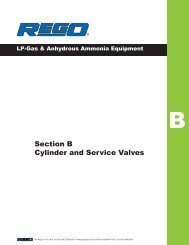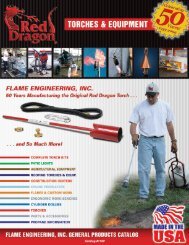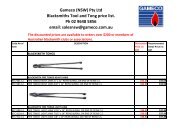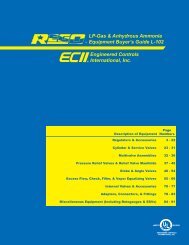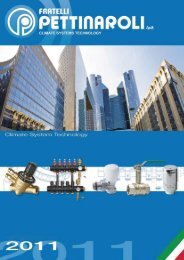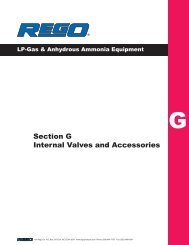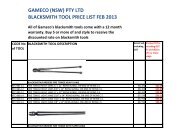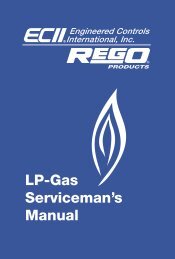Repair Kits Available By Part Number Section 2 Page - GAMECO
Repair Kits Available By Part Number Section 2 Page - GAMECO
Repair Kits Available By Part Number Section 2 Page - GAMECO
You also want an ePaper? Increase the reach of your titles
YUMPU automatically turns print PDFs into web optimized ePapers that Google loves.
Lock Lever<br />
Lever Spring<br />
Lever Pin<br />
A7707-50 <strong>Repair</strong> for A7707L<br />
and A7708L Quick-Acting<br />
Hose-End Valves<br />
Lever<br />
* Bonnet<br />
Washer<br />
* O-Ring<br />
Seal<br />
Housing<br />
* Pressure<br />
Seal Rings<br />
* Jam Ring<br />
* Upper<br />
Washer<br />
Upper<br />
Spring<br />
* Seal<br />
Housing<br />
Gasket<br />
Bonnet<br />
A7708 Body<br />
Stem<br />
Assembly<br />
Stem Assembly<br />
* Groove Pin<br />
Seat Disc & Retainer Assy – Figure 2<br />
Swivel Pin<br />
Stem Holder<br />
Seat Disc<br />
Retainer<br />
*Seat Disc<br />
Stake nut here<br />
Lower<br />
Spring<br />
Stem<br />
Gasket<br />
Swivel Pin<br />
Stem<br />
Holder<br />
Seat Disc<br />
Retainer<br />
Seat<br />
Disc *<br />
Lower<br />
Washer<br />
Nut<br />
Body<br />
Gasket *<br />
A7707<br />
Body<br />
* Denotes parts<br />
included in repair kit.<br />
WARNING: Installation, disassembly, repair and maintenance must be<br />
performed only by qualified personnel.<br />
Remove all pressure from system before removing hose-end valve,<br />
then release lever lock and lift lever to vertical (valve open) position.<br />
Remove entire valve from line before performing repairs.<br />
Installation, usage and maintenance of this product must be in compliance<br />
with all Engineered Control International, Inc. instructions as well<br />
as requirements and provisions of NFPA #54, NFPA #58, DOT, ANSI, all<br />
applicable federal, state, provincial and local standards, codes, regulations<br />
and laws.<br />
Inspection and maintenance on a periodic basis is essential.<br />
Be sure all instructions are read and understood before installation,<br />
operation and maintenance. These instructions must be passed along<br />
to the end user of the product.<br />
CAUTION: Contact or inhalation of liquid propane, ammonia and their<br />
vapors can cause serious injury or death! NH 3<br />
and LP-Gas must be<br />
released outdoors in air currents that will insure dispersion to prevent<br />
exposure to people and livestock. LP-Gas must be kept far enough<br />
from any open flame or other source of ignition to prevent fire or<br />
explosion! LP-Gas is heavier than air and may not disperse or evaporate<br />
rapidly if released in still air.<br />
Disassembly and <strong>Repair</strong> Procedure<br />
CAUTION: READ THROUGH ALL OF THESE INSTRUCTIONS, INCLUD-<br />
ING THE NOTICE AND WARNINGS ON THE BACK OF THIS SHEET,<br />
BEFORE BEGINNING ANY DISASSEMBLY OR REPAIRS.<br />
NOTE: Before repairing valve, thoroughly examine valve lever and all associated<br />
parts for excessive wear. Check valve handle for proper functioning,<br />
and ACME threads for excessive wear and damage. Check surface of filler<br />
connector that seats on filler valve gasket when the valve is used, and make<br />
sure it has a smooth surface. Any components that are not in good condition<br />
and fully operational should be replaced during repairs.<br />
<strong>Repair</strong>s must be performed in a clean area. Hands, clothing, tools and work<br />
area must be completely free of oil, grease and foreign matter to prevent<br />
contamination of component parts and valves.<br />
Disassembly<br />
1. EVACUATE ALL GAS FROM THE SYSTEM BEFORE ANY DISAS-<br />
SEMBLY OR REPAIR. Release lever lock and lift lever to vertical (valve<br />
open) position.<br />
2. Remove entire valve from line. Clamp the valve body in a vise by the hex<br />
end section of the body inlet.<br />
3. With valve lever in the open position, remove entire bonnet assembly by<br />
turning clockwise (left-hand threads), using a 11 11 /16" wrench.<br />
4. Remove body gasket and discard.<br />
5. Clean cement residue from body threads using a wire brush. Thoroughly<br />
clean all parts of body assembly. Set valve body aside for later<br />
reassembly.<br />
6. Clamp the hex section of bonnet in vise.<br />
7. While holding the top of seat disc retainer on flats with a wrench, use<br />
another wrench to remove the seat disc retaining nut.<br />
8. Remove and save lower washer, take out and discard seat disc.<br />
9. Immerse new seat disc in water immediately prior to assembly.<br />
10. Install new seat disc by pressing into recess of seat disc retainer.<br />
11. Apply two 1 /8" strips of Locktite across threads on opposite sides of seat<br />
disc retainer.<br />
CAUTION: Do not allow Loctite to contact seat disc.<br />
12. Place lower washer on seat disc retainer and thread on disc retaining<br />
nut. After tightening firmly with a wrench, stake nut in two places at<br />
retainer thread to prevent loosening (see figure 2).<br />
13. Return lever to horizontal (valve closed) position.<br />
14. Knock out groove pin with a 1 /4" drift pin.<br />
15. Remove lever. Discard bonnet washer.<br />
16. Pull stem assembly with lower spring out from bottom of bonnet, and<br />
keep together. Carefully inspect stem for scoring and scratches in the<br />
stem seal area. Deep grooves or scars are cause for replacement of<br />
stem and spring.



